 |
 |
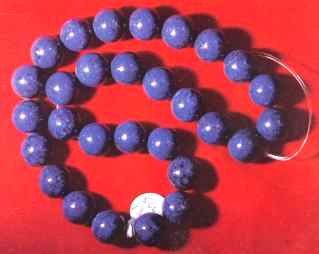 |
| 処理前(beore coating) | 処理後(after coating) | |
| アクリルコーティング処理(Acrylic spray coating) 23.29ct | オイル処理されたアフガニスタン産ラピスラズリ These lapis-lazuli beads from Afghanistan were found to have been oil treated | |
ラピスラズリ(Lapis-lazuri)
3.模造品(Fakes and
Immitations)
何千年もの昔から珍重されてきたラピスラズリですが、唯一の産地はアフガニスタンの山奥となれば容易なことで手に入るものではありません。となればお決まりの模造品やら贋物等々、あの手この手が横行するのも当然のことです。
最近のことですがパリのルーブル博物館にある古代エジプトの金とラピスラズリ製の胸飾りが実は本物ではなくラピスラズリの粉末とシリカ粉末とを混合して焼き上げたフリッツと呼ばれるセラミックの一種であったことが判明しました。
最先端技術を用いたPIXE(粒子励起X線分析法)による精密な化学組成と構造分析とで明らかになったのです.
おそらく、古代エジプト人が加工の際に出た貴重なラピスラズリの粉末の再利用のためにあれこれ工夫したのでしょう。
Laps-lazuli has been appreciated since several thousands years from Afghanistan, which was an only supply source and volume was limited, which resulted in the appariton of varieties of enhancements and immitations.
Recently, there was an interesting report on gem-set gold Egyptian pectorals from the Louvre collection. PIXE(Particle Induced X-ray Emmision) analysis was used to determine the chemical compositions of the gem material and metal. In the course of their study, it was found a tyep of manufactured gem material known as "frits" which is composed of a mixture of lapis-lazuli and silica powders.
1. ラピスラズリの処理加工 (Enhanced Lapis-lazuli)
 |
 |
 |
| 処理前(beore coating) | 処理後(after coating) | |
| アクリルコーティング処理(Acrylic spray coating) 23.29ct | オイル処理されたアフガニスタン産ラピスラズリ These lapis-lazuli beads from Afghanistan were found to have been oil treated | |
不透明な宝石の場合、品質や研磨の悪さを隠すために様々な表面処理が行われます。
上の二つはいずれも本物のラピスラズリですが質も研磨も悪いものをアクリル・スプレイとオイル処理で色合いを良く見せかけた例です。
いずれも使っているうちに表面処がはがれて下地が現れ、まさにぼろを出します。
実物は感触や爪でこすったり、ビーズの孔の部分のオイル溜まり等により処理されていることが比較的簡単に分かります。
It is well known that various surface coatings are used on gems to improve the appearance.
Two examples shown avobe photos are examples of acrylic spray and oil treatment. Although the surface appearance of gems are improved in luster, the treated gems appeared to have a somewhat unnatural, glassy appearance with magnification. And it is not difficult to identify these treatments because the coating can be easily scraped with razor blades and careful observation around drill holes reveals heavy concentration of oils.
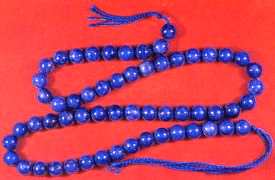 |
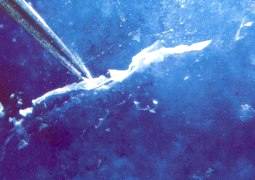 |
 |
| 染色され、されにパラフィンコート処理品 Dyed and coated lapis-lazuli with paraffin |
x10
表面のワックスが剥がされたビーズ Brush probes reveales wax coating. |
染色され、さらにワックスコート処理品 Dyed and coated lapis-lazuli with wax |
染色処理された質の悪いラピスラズリが宝飾品として出回ることは良くあることです。
しかし汗や、アセトン(マニュキアの除光液の主成分)を染み込ませた綿棒でビーズホールの部分をこすると色が落ちるので比較的簡単にそれと見破ることが出来ます。
そのためにさらにパラフィンやワックスをかけて簡単に染色が露呈しないように手の込んだ処理がされたものが数多く出回ることになりました。
しかしながらこうした処理品は色が不自然に濃いものや、処理による不自然な光沢や感触があります。
さらに表面のパラフィンやワックスはナイフや針で簡単に剥れるため、それと分かります。
Dyed lapis-lazuli is easily detected because dye stains skin and cloths., or when acetone applied with a cotton swab produces evidence of dye. Therefore dyed stone is often "sealed" with some type of oil, wax or the like. However these treatments can be revealed with their unatural color, luster, touch and surface treatments are scraped off with knives and proves.
2. 様々な鉱物等による模造品 (Lapis-lazuli immitations made of various minerals)
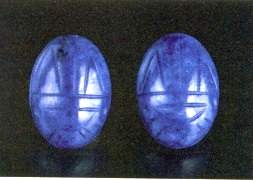 |
 |
 |
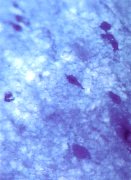 | |
 | ||||
| 染色された長石のスカラベ 右写真は15x拡大で亀裂への色素の沈着が見える left : Dyed fedlspar scarabe right : 15x dye concentrations are seen in fractures |
染色された珪岩のビーズ 右 25x 亀裂に沈着した顔料 Dyed quartzite bead 8mm right : 25x dye concentration seen in the pit and fracture of quartz | |||
一見ラピスラズリ製のスカラベはしかし、10倍に拡大すると色合いがソーダライトのように見える上に顕著な色むらがあります。 X-線分析により実は着色された長石であることが判明した例です。
欠けたビーズの内部に色がないために調査を依頼された右の写真のビーズはラピスラズリではなく染色された珪岩であることが判明しました。
表面にまだらな色素の沈着があることから、たとえ割れなくても染色されたことが明らかです。
The pair of blue scarabe superficially resembles lapis-lazuli but with 10x magnification the material looked more like sodalite, except that the color distribution was "wrong". More testing including X-ray diffraction anlysis, proved that the mineral was dyed feldspar.
A broken bead with colorless internal portion was examined to reveal not lapis-lazuli, but dyed quartzite.Magnified photo reveals the uneven dye concentration around the bead surface.
染色された苦灰石 右は15倍に拡大された切断面
Dyed dolomite and right : 15x magnified bead染色された方解石ー大理石 右 染色が剥れた部分 25x
Dyed calcite-marble beads right: A chipped area near drill holeスイス・ラピス ?
Swiss-lapis ?
左のきれいなラピスラズリのような青い色のビーズは、染色されたハウライト [Ca2B5SiO9・(OH)5] のラピスラズリ模造品として売られていました。
ハウライトとは聞きなれない名前です。普通は無色の鉱物ですが、稀に淡青色に染められてトルコ石の模造品として使われる鉱物です。
ところが調べると実はハウライトではなく、苦灰石でありました。
中央は大理石ー方解石を着色した模造品です。剥れた部分が10%の希塩酸に反応して泡だったことで石灰岩であることが判明しました。
右のX線写真は ”スイス・ラピス” と称する青い色のネックレスでしたが、肌が青く染まったため調べたところ、灰色のビーズが ”スイス・ラピス” と呼ばれるジャスパーで、白く写っているのは方解石であることが判明しました。
Attractive blue beads strand on the left photo was originally represented as dyed Howlite[Ca2B5SiO9・(OH)5] immitation of lapis-lazuli. Howlite is, in general colorless mineral and rarely dyed skyblue to be marked as turquoise immitation. However it is actually determined as dyed dolomite and not howlite.
Center photos are lapis-lazuli immitaion of dyed calcite-marble. A chipped area near the drill hole reacted with 10% hydrochrolic acid solution and effervesced with carbon dioxide.
X-ray photo on the right is an example of lapis-lazuli immitation with dyed mixed stones. It was sold as "Swiss-lapis", that stained skin of client with blue. The test revealed the necklace as mixture of two different dyed stones : whiter beads in the X-ray photo is calcite and less oppaque one is jasper.
 |
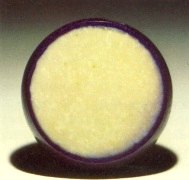 |
 |
 |
| 染色された大理石ビーズ 11.9mm と 右 断面 left : Dyed marble bead 11.9mm right ; Cross section of bead |
冷却時に晶出したクリストバル石の微晶を含む不透明なコバルトガラス 左(left) 6x 右(right) 13x magnification of lapis-lazuli immitation of opaque cobalt glass with dendritic and radiating white low-cristobalite crystals | ||
大粒のラピスラズリを思わせるビーズですがアセトンでは脱色されず、また希塩酸10%液で暗青色の染みが落ちました。が、本物のラピスラズリなら塩酸との反応による硫化水素の発生がある筈ですが無臭でした。
おそらく他の鉱物に着色したものと切断したところ周囲だけが着色されたビーズであることが判明しました。X線分析で大理石と確認されました。
右のビーズの ”インド産の濃紺色の水晶” との但し書きがまず疑惑を呼びました。そんな水晶は天然に存在しません。この直径8mmのビーズは不透明でしかも樹枝状に放射する微結晶構造のインクルージョン入りという珍しいものです。
様々な検査の結果、このビーズは不透明なコバルトガラスで、樹枝状の結晶はガラスの冷却時に離溶した珪酸分が低温型のクリストバル石に晶出したものと判明しました。
When tested this bead for dye with an acetone-soaked cotton swab, no stain was produced, however when a solution of 10% hydfrochloric acid was used, a very dark blue stain was observed. Although the material effervesced to the acid, there was no hydrogen sulfied odor, leading to suspect that the bead was a dyed substance other than lapis-lazuli. Then polished half of the bead revealed the dyed face. With further testing with X-ray diffraction confirmed that the material had a calcite pattern.
Hearing of an "intense blue quartz from India" was intriguing enough to arouse the suspicion. Intense blue quartz does not exist in the nature. This 8mm dia. bead is opaque with dendritic and radiating white micro crystal inclusion. After various examination, this bead was identified as opaque man-made cobalt glass. And dendritic crystal is identified natural alpha-cristobalite, which is known to exsolve from certain glass types through a devitrification process.
セラミック・合成ラピスラズリ(Ceramic/Synthetic lapis-lazuli)
以上は全て主に低品質のラピスラズリや他の鉱物などを染色やワックス処理したものです。
これらは色が落ちたり、光沢が褪せたり、いずれも質の悪い贋物に過ぎません。
これらの贋物に対して、以下に示すのは、本物ではありませんが、宝飾用途として耐久性のある代替品の例です。
Above-mentioned are dyed or treated low quality lapis-lazuli or other mineral immitations. While followings are, although not real lapis-lazuli, examples of durable, much better quality simulants, suitable for jewelry use.
 |
 |
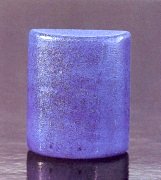 |
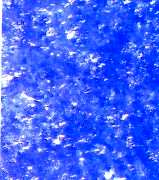 |
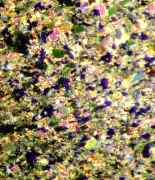 | |
| ラピスラズリ粉末をポリマーで固めたもの ”Reconstructed Lapis-lazuli” |
新しいタイプの合成またはセラミック・イミテーション 4.09ct 中央は 22倍の拡大写真 白く見えるのは黄鉄鉱 右は80倍の偏光顕微鏡写真 New type of synthetic or ceramic immitation 4.09ct Center : 22x magnified photo,showing white pyrite crystal and dark blue grains right : 80x crossed polarized photo | ||||
はじめの二つはいずれも自然な色合いと光沢を持ち、黄鉄鉱のインクルージョンまで入っているルースです。再生ラピスーラズリとして販売されているものです。
トルコ石にも同様に粉末を固めた "再生トルコ石” があり、それをうかがわせる名称ですが、しかしX線分析の結果からは、ラピスラズリではなく、硫酸バリウムを主成分とするポリマーで固めた全くの人工の物質であることが確認されました。 しかし大変美しいものではあります。
右の断面が半月形のカボションはアメリカの GIA が1992年に入手した上質のラピスラズリを思わせるイミテーションです。しかし GIA の研究所の分析ではその正体が確認できず、カリフォルニア工科大学の協力を得て最先端の分析機器を駆使して1年がかりの分析の果てにようやく、それが雲母を主体とし、おそらく天然のアフガニスタン産のラピスラズリ粉末と黄鉄鉱を混ぜて固めたセラミックの一種との結論に達しました。
誰がどうやって作ったものかは不明です。
First two pieces of caboshon and block are material marketed as "reconstructed" lapis-lazuli that have a very natural appearance. However, various gemological tests and X-ray diffraction analysis revealed a strong pattern for barium sulfate(BaSO4), with pyrite inclusions bonded with polimar.
The opaque, slighgtly violetish blue 4ct rectangular bar-cut caboshon on the right, appeared to be the fine lapis-lazuli. The G.I.A. obtained this simulant in 1992 for gemological analysis. But the West Coast Laboratory alone could not identify this stone and it took one year with colaboration of the California Institute of Technology, using the most sophistifated equipments, such as SEM(Scanning Electron Microscope), ESD(Energy Dispersive Spectrometer), etc., etc., and was concluded as a manufactured phlogopite ceramic, mixed with Afghan lapis-lazuli. It is not known who and how this material was manufactured.
 |
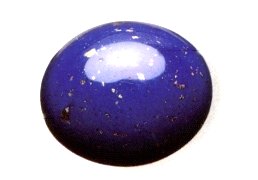 |
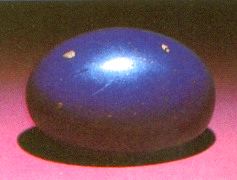 |
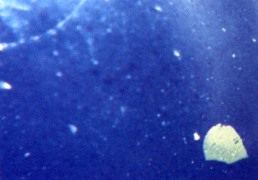 |
| フランスのギルソンによる合成ラピスラズリ 左(left) 70mm 右(right) 6.53ct Synthetic lapis-lazuli by Pierre Guilson, France |
新しいタイプの合成 ? 4.09ct 右の写真は 22x の拡大写真 白く見えるのは黄鉄鉱 New type of synthetic lapis-lazuli ? right : 22x magnified photo with white pyrite crystal and dark blue grains | ||
合成ラピスラズリとして一般に知られているのは数々の合成宝石で有名なフランスのピエール・ギルソンが1974年に ”Created Lazulite” の名で商品化したものです。写真のように深く均質な紺青色の地に黄金に煌く黄鉄鉱粒が散りばめられたもので、まさにアフガニスタン産の最上級品を偲ばせる出来映えです。しかしながら分析の結果では合成ウルトラマリンに黄鉄鉱が混じったセラミックで、ラピスラズリよりはソーダライトーノゼアン系の鉱物に近いものです。
最後の4.09ctのカボションは1983年に出現したイミテーションで、ギルソン製を思わせるものですが、屈折率や比重がやや低く、X線解析による分散パターンもギルソンとは異なるため、別種の合成イミテーションとされたものです。これも誰がどうやって作ったのかは不明です。
P.Guilson, a renowned French manufacturer of various synthetic gemstones announced in 1974, "Created Lazulite", which is well known as synthetic lapis-lazuli, in general. The quality is, as shown in photos, equivalent to the highest grade Afghan lapis-lazuli for superbe ultramarine blue with golden pyrite matrix. However, X-ray analysis revealed its structure and compositions as ceramic of synthetic ultramarine mixed with pyrite. It should be called synthetic sodalite-nosean, rather than lazulite.
The 4.09ct caboshon appeared in 1983 resembled Guilson's symulant but, analysis revealed that this should be new type of synthetic simulant. This stone has slightly lower R.I. and S.G. and X-ray diffraction patter is different from that of Guilson, neither. It was not known who and how this symulant was made.